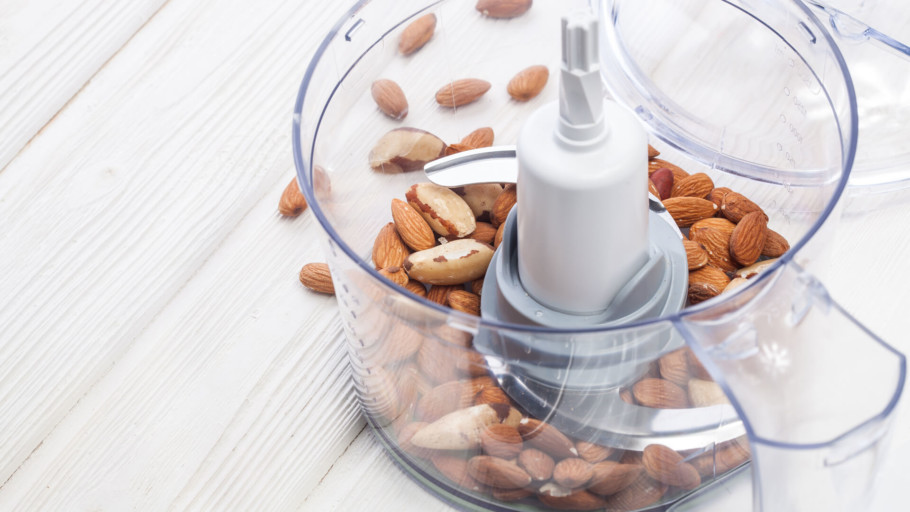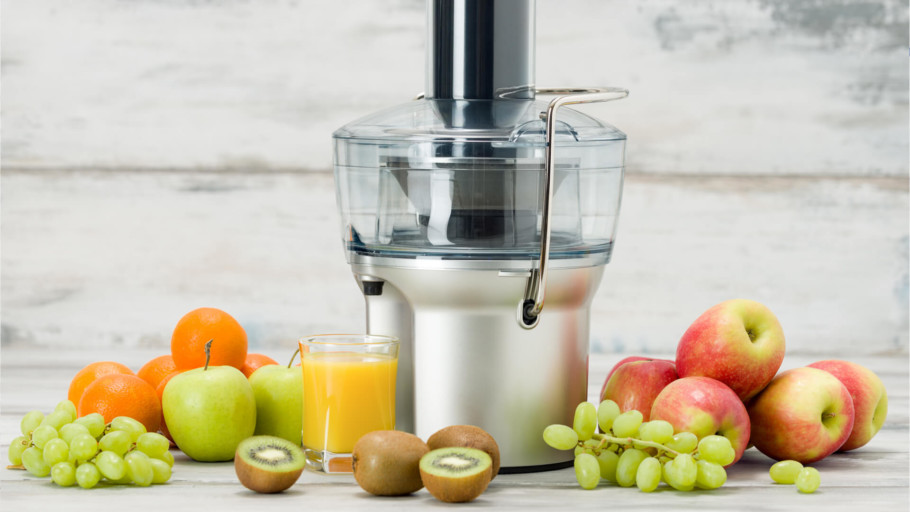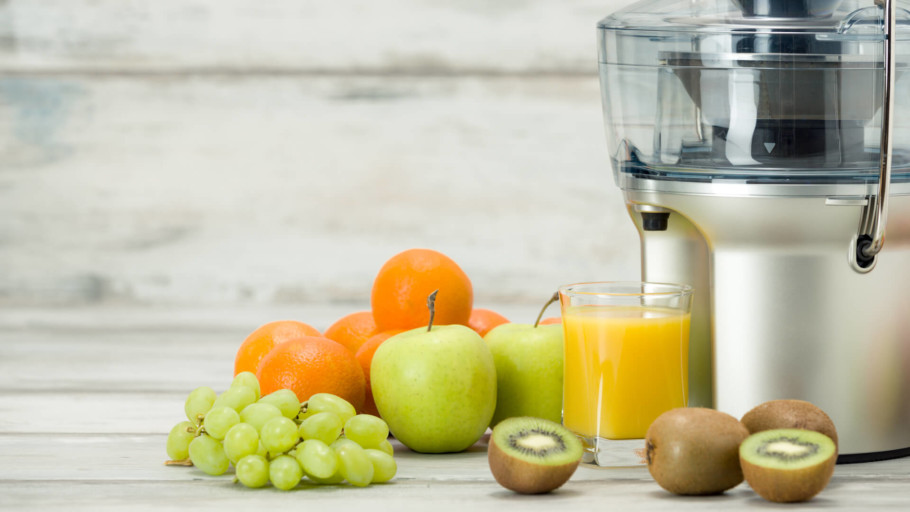Food Processors, Juicers and Blenders – What’s the Difference?
There are a number of kitchen gadgets that many would find indispensable today, with food processors, juicers and blenders amongst the most useful. If you’re looking to eat more fresh produce, drink more nutritious smoothies, or make some delicious homemade soups, then you’re likely considering buying one of these appliances for your own kitchen.
Unfortunately, many people get caught up in determining the differences between these useful appliances. The fact is, the mechanics of each differs, and they all have their own merits and pitfalls. To help you decide whether a food processor, juicer, or blender is the correct purchase for you, we have compiled this comprehensive guide to the differences, advantages, and drawbacks of each of these appliances.
Food Processors

How a Food Processor Works
A food processor has a wide bowl and a low blade that moves at a moderate speed to chop up whole produce placed within it. Most food processors will come with a variety of blades that will suit different vegetables and will also enable the user to blend, slice, dice and rice.
Best Uses for Food Processors
A food processor is best for chopping and blending ingredients together. If you love to make anything from homemade burgers to pizza dough, then this gadget is a must. It will combine ingredients efficiently and consistently to give you delicious results. In the current climate where cases of obesity and diabetes are rising; a food processor will help you to create fresh, homemade alternatives to unhealthy packaged sauces, pestos and curry pastes, rice cauliflower as a regular rice substitute, or make your own healthy nut butter with little fuss.
Pros of a Food Processor:
- Quick: if you love to cook meals from scratch, then you will certainly benefit from a food processor. It cuts down on food preparation time so you can just throw the raw ingredients together in the pan and blend up delicious sauces and flavorsome pastes in just a few minutes.
- Uniform chopping and slicing: If you’re one for food aesthetics, then the uniform way a food processor chops your vegetables and salad will be appealing.
- Healthier: Using a food processor means quicker food preparation, which in turn means you’re more likely to cook healthy home-made meals. If you’re trying to cut down on your carb intake for health reasons, then it is also handy to have a device to easily rice cauliflower and broccoli for regular rice substitutes.
- Great for amateurs: Whether you are a college student starting to cook for yourself or a budding food adventurer, your cooking journey will be made easier with a food processor by your side. Instead of learning to chop and dice efficiently by hand, a food processor will do the hard work for you.
- Multi-purpose: A food processor is extremely versatile and can make a wide array of dishes extremely easy for you to cook. Many models come with a range of blades which can be replaced for different styles of chopping and blending.
Cons of a Food Processor:
- Chunky food: the wide bowl of the food processor means that liquid usually gets sloshed around the edges rather than being blended with the food. This tends to provide thicker and chunkier results. Therefore, it may be disappointing if you’re looking for perfectly smooth soups, juices and sauces.
To summarize, food processors are versatile appliances that can be used for a variety of kitchen activities. You can chop salads, blend chunky soups or doughs, and prep base sauces and pastes for a variety of different dishes with ease. Unfortunately, however, if you prefer soups and sauces with a smoother consistency, you will struggle to get the results you’re after with a food processor.
Juicers

How a Juicer Works
As the name suggests, a juicer is designed for juicing fruits and vegetables. They are useful tools, and the more powerful models can turn the toughest fruits and vegetables into a smooth and nutritious liquid. In general there are two types of juicers: masticating juicers and centrifugal juicers.
Masticating juicers use a pressing and crushing technique to extract juice from produce. They crush the cell walls of the fruit to release the juices, ultimately creating less waste and a greater yield in juice content. They are also much more efficient with smaller and drier produce, such as leafy greens. Masticating juicers are usually the more expensive option of the two. On the other hand, a centrifugal juicer finely grates the produce and then spins it to separate the pulp and juice. The pulp is usually collected in one container, while the juice travels down to a collection jug. This type of juicer is usually more affordable.
Best Uses for a Juicer
Juicers are best used for juicing fruit and vegetables. They cannot be used to make smoothies, pastes, or chunky soups. If you’re looking to increase your vitamin and mineral intake without eating more food, then a juicer will surely help you achieve this. Thus, if making juice is primarily what you want to do with your new kitchen appliance, this is the one to go for. While it’s true that a blender could be used to achieve similar results by finely straining the resulting liquid, this is undoubtedly time consuming and messy. As always, it is better to have a dedicated appliance for the job if it’s something you want to do on a regular basis.
Pros of Juicers:
- Quick Health Boost: A freshly made vegetable and fruit juice packed with vitamins and minerals is easy to consume without filling you up. This is a great way to maintain good health without loading your plate with extra veggies or snacking of whole fruit throughout the day. Many people prefer the simplicity and texture of fruit and vegetable juices, as opposed to thicker smoothies created by blenders. There is also some evidence to suggest that by juicing fruits and vegetables your body can absorb the nutrients better since it does not have to process all the fiber.
- Great way to eat leafy greens: leafy greens are great for detoxing and for gut health, but they are notoriously difficult to consume in large quantities for most people. Juicing them alongside a lemon or apple makes them more palatable and easier to ingest, giving you benefits that a food processor or blender cannot.
Cons of Juicers:
- Food Waste: unfortunately, there is a lot of waste created when juicing fruit and vegetables. This is especially true for centrifugal juicers since there is lots of pulp left at the end of the juice-making process. Unless you are able to compost or find another use for the waste, some may find this difficult to justify.
- Removes Fiber: Fiber is essential for a healthy body. Unlike blenders or food processors, juicers remove all the pulp from fruits and vegetables, so there is very little fiber in the resulting juice. Depending on your personal eating habits, this may mean you’ll need to compensate for the lack of fiber in your day-to-day diet to stay healthy.
- Difficult to Clean: Juicers are one of those gadgets that can be easy to use but difficult to clean. The various blades and grating mechanisms are very fine, and it can be difficult to get fruit and vegetable residue out of them in a non time-consuming way. If you are planning to use a juicer often, you should be prepared to spend a significant amount of time cleaning it.
- Large: Juicers are generally large and bulky appliances. Therefore, they can be awkward to store, especially if you are short of space in your kitchen.
Juicers are a very specific appliance which lack flexibility. If creating fresh juices is what you are looking to do with a new kitchen gadget, then this is clearly the one for you. Powerful models can take tough fruits and vegetables and turn them into a nutrient-packed and easy to consume juice that you can drink in seconds. Unfortunately, if you’re looking for a versatile appliance that can assist with food preparation, chopping and blending, then this isn’t for you. You should also note that many juicers are notoriously awkward to clean after each use and some of the higher-end masticating models are rather pricey.
Blenders

How a Blender Works
A blender usually has an upright and narrow jug with a small fixed blade in the bottom center. They tend to come with powerful motors that are designed to pulse coarse and tough food into smoother pastes and blends. Most have a high volume capacity and can easily blend up a generous portion of roasted vegetables into a smooth aromatic soup for the family’s dinner time. Blenders are highly versatile as well and can be adapted to perform tasks similar to food processors.
Best Uses for Blenders
Blenders are best used for making soups, sauces, smoothies, and baby food. You can add a large volume of cooked or raw produce, and with a sufficient amount of added liquid, turn it into a smooth and palatable blend. The jug design makes it easy to pour contents out straight into a glass or bowl with little mess.
Benefits of Blenders:
- Quick: blending is incredibly quick. You can throw in whatever you want with a sufficient amount of liquid, and a few pulses will give you results
- Filling: Compared to juicers, using a blender to create fruit and vegetable smoothies provides thicker results which will keep you fuller for longer.
- Less Waste: Since the pulp is absorbed in the liquid, there is no food waste like there is when juicing
- Create Delicious Pastes and Soups: Blenders can create the smoothest of soups, curry pastes, and baby food.
- Versatile: Blenders are the most versatile of the three gadgets in question. You can mince fruit and vegetables in it similar to a food processor, or with a fine net, it is possible to sieve any blended cocktail for a smooth and fine juice.
- Easy to Clean: With essentially just one jug with a fixed blade, blenders are very easy to clean and store away after use. You can simply fill with warm water and some dish soap, run the blades for a few moments, and rinse.
Drawbacks of Blenders:
- Consistency: If you don’t have a high-powered blender then it may not deliver the perfectly smooth results you want the first time around. You may have to run the blender multiple times and keep adding liquid to get the desired consistency.
- Storage: Due to the size and upright design, blenders can be difficult to store away, so they may need a permanent space on your kitchen counter
Blenders are incredibly versatile and can be used for a variety of different purposes. They can make you anything from smoothies to soups and can blend or chop up the toughest of ingredients. There is a vast variety of blenders on the market to suit every budget. You can also use a blender along with fine mesh to give yourself juicer-like results. They are easy to clean and produce no waste. Unfortunately, some lower-powered blenders may take longer to provide super-smooth consistencies, and the height of many units can make them difficult to store.
Comparison Table:
| Food Processor | Juicer | Blender | |
| Chopping & Dicing | ✓ | X | ✓ |
| Soups | X | X | ✓ |
| Smooth Juices | X | ✓ | X |
| Smoothies | X | X | ✓ |
| Doughs | ✓ | X | X |
| Butters | ✓ | X | ✓ |
| Dips | ✓ | X | ✓ |
| Shredded Cheese | ✓ | X | ✓ |
| Food Waste | X | ✓ | X |
| Easy Cleaning | X | X | ✓ |
Final Thoughts
Food processors, juicers and blenders are all smart appliances which help make modern cooking and food preparation easy. Food processors can go a long way to cut out time spent on chopping and dicing. They are a versatile gadget that will suit those who like to make meals from scratch. A juicer, on the other hand, may not feel necessary; however, it is a great investment for the health conscious individual. Juicers will help you to consume fruits and vegetables easily, without any fuss. Unfortunately, not only are they awkward to clean, but the food waste may also weigh on your conscience and they are very specifically for juicing.
A blender is probably the most versatile of the three gadgets. From smooth soups to sauces and smoothies, a blender is capable of performing many tasks. The vast variety available on the market means there’s an affordable choice for every price range, although cheaper and lower-powered options may struggle to produce smooth results quickly, and they are not able to create juices to the same quality as a juicer, even if the mixture is strained after blending.
We hope this guide has helped you to decide which appliance is best for your particular culinary needs. No matter which appliance you choose, we’re sure you’ll agree that each of these kitchen gadgets is worthy of a place in any modern kitchen.

